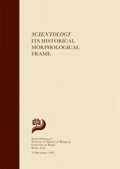Scientology is a “prophetic” religion, born out of the teachings of a charismatic founder, L. Ron Hubbard, who holds the place that Gautama, the Buddha, has in Buddhism, Christ in Christianity and Muhammad in the Islamic religion (the three great religions of today). Unlike Christ and Muhammad, Mr. Hubbard did not claim godhood or that he was visited with divine revelation. Like Gautama, Mr. Hubbard claimed to be a man who had discovered a path to spiritual enlightenment, salvation and freedom.
L. Ron Hubbard published in 1950 the successful book Dianetics: The Modern Science of Mental Health. The book promised “self-achievement” (or achievement of “static life”) against the frustrations of the exterior world (chaos), with axioms supported by socio-anthropological, historical-religious, philosophical-religious arguments. It is a fact that this book’s success generated a religion, Scientology, in which Dianetics is now subsumed. One should not be fooled by the scientific premises the name “Scientology” derives from. It is a modern religion which, just by virtue of being modern (or fit for the people of today), introduces itself as scientific. In this regard I will cite two similar cases, on whose religious consistency there are no doubts: Bahaism in the Islamic realm, and Christian Science in the Christian realm.
Bahaism started during the last century; it took its name from the title of its founder, Baha’Ullah (“Splendor of God”), who had already been a follower of Babism, a religious movement in Islamic Persia. Among the most important soteriological propositions of Bahaism is the unity between science and religion.
Christian Science was founded around the end of the last century by the American prophet Mary Baker Eddy. This religion originates with psychosomatic medicine. As in the case of Mr. Hubbard’s popular book on “mental health,” Christian Science also started with a popular book written by Eddy and published in 1875 as Science and Health. “Health” is the same thing as “salvation” for these prophet authors who, in this way, more or less resume the Latin concept of “salus.”
The first Scientology religious community was founded as a church in 1954, with the name Church of Scientology of California. In this way the religion perfected itself, organizing itself on the Christian ecclesiastical model. The Churches of Scientology spread in various towns in the English-speaking world (Canada, Australia, South Africa, England and the United States); as well as to France, Germany, Denmark, Holland, Italy and Sweden. Other European countries (Belgium, Austria, Ireland) and extra-European countries (Japan, Korea, India, Israel, Mexico) were reached by Scientology missions and churches.




























